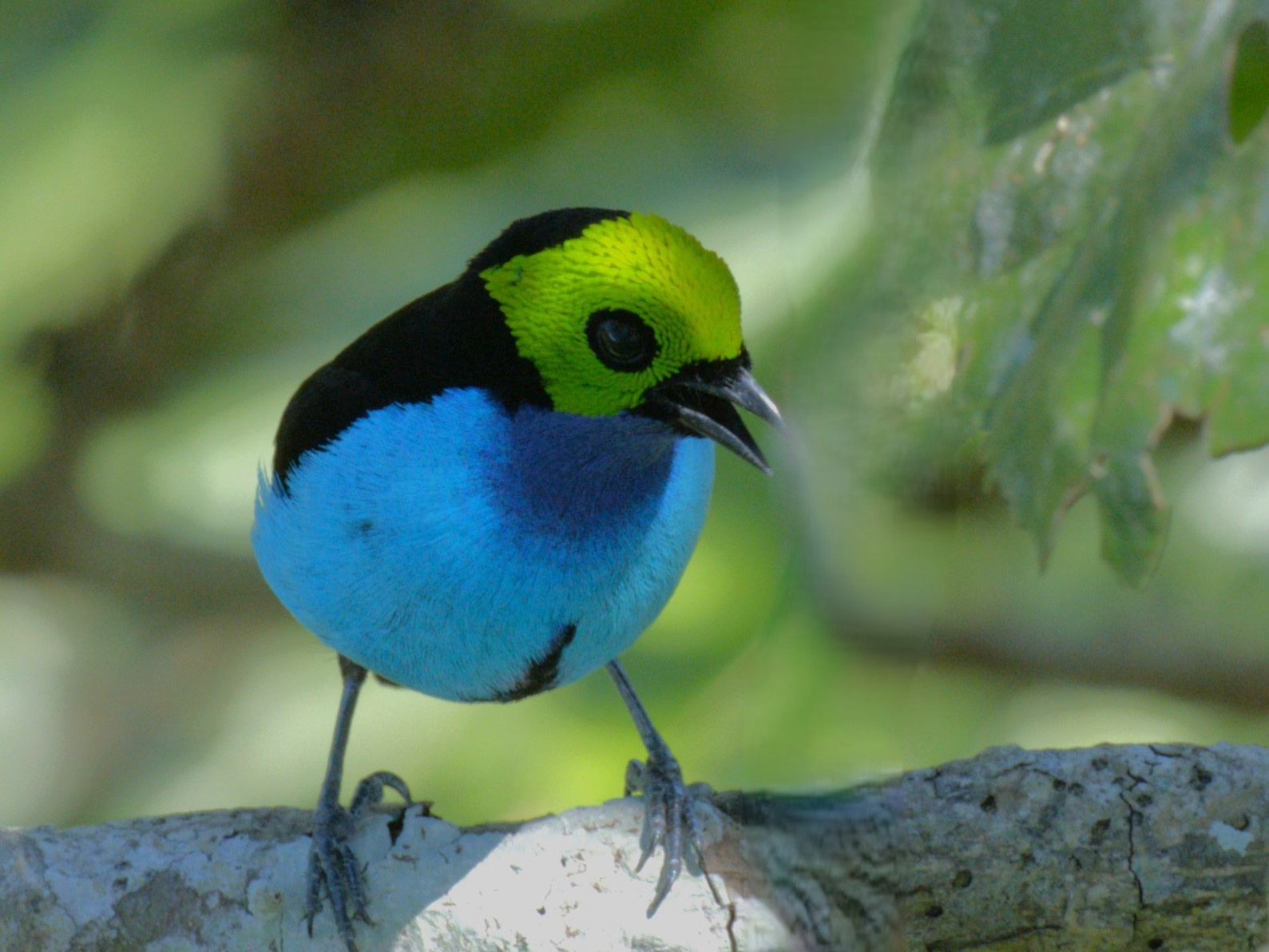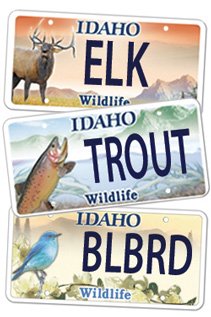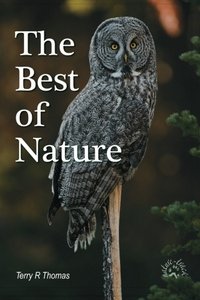Why are Tropical Birds so Colorful?

©Terry R. Thomas/www.nature-track.com
The Paradise Tanager is a wildly beautiful bird. Why is it so colorful?
In preparation for a presentation on the birds we saw while in Ecuador recently, I was struck by how many of the birds were extravagantly colored, many eye-poppingly so. Thumbing through my field guides for North American species it seemed to me that North American birds, on average, are not as colorful as tropical species. This was even true when comparing the birds of the Andes Mountains uplands of Ecuador to the tropical and cloud forest species. The uplands species were strongly skewed to the browns and grays, not the bright colors of their forest neighbors.
It turns out that my brilliant observation has been noted by scientists for centuries. “The closer one gets to the tropics, the greater the variety of structures, graceful forms and color combinations.” So said German naturalist, geographer, and explorer Alexander von Humboldt (1769-1859). So, one big question: is it really true that tropical birds are more colorful than other species or is it just an illusion?
That question was answered in 2022 with results of a study on that subject published in the scientific journal, Nature Ecology and Evolution. The researchers studied 4500 species of songbirds to determine that tropical species, on average, are 30 percent more colorful than their temperate neighbors. So, despite being a bit slow on the uptake, my observation was correct. If you want to see the most colorful birds, head to the tropics.
However, that does not answer the question, why are tropical birds so colorful? In one sense, this seems to violate the assumption that being colorful likely leads to becoming a meal much more readily than being cryptic. The researchers have a theory for that too.
Ecuador, a country the size of the state of Colorado, is home to a dazzling array of bird species, nearly 1700 in all, compared to North America’s roughly 1000 species. This means that the number of species of songbirds in this case, living in close proximity is much higher in the tropics than in higher latitudes. In addition, tropical forests are dark places where it is easy to blend in. And blending in may be a problem, according to the researchers. They determined that, “enhanced colourfulness may help them (the birds) to distinguish themselves from all the other birds in their rich tropical communities—a necessary skill to avoid potentially costly interactions with other species, which could even include mating.”
So, in the gloomy world of a tropical or cloud forest (a cloud forest is just as dense, but is at higher elevation than a tropical rainforest) the need to be able to recognize their own species trumps the need to not advertise their presence to predators.
So that might answer the why, but what about the how? The authors of the study did not leave us hanging there either. Tropical and cloud forests are highly productive because of three things. First, being near the equator, day length is consistent year-round. Second, again because they are near a latitude of zero, temperatures are consistently warm. Third, there is abundant moisture. These create a richness of food, meaning, according to the authors, the birds are better fed and the living is easy. Extra energy could be devoted to evolving unique feather coloration. Also, “With more energy, they can communicate more with other birds, which colorful appearances can come in handy for.”
As Alfred Russel Wallace, a 19th century British naturalist, once said: “There is probably no one quality of natural objects from which we derive so much pure and intellectual enjoyment as from their colours”. For us, the colors and combinations of colors that we see with tropical birds are indeed delightful, but for the birds they are not just pretty, they are how they can communicate within their shadowy world.
Help Idaho Wildlife
When we traveled across the state in October 2017, we visited most of the Idaho Department of Fish and Game wildlife management areas. Most of the vehicles we saw using the wildlife management areas did not have wildlife plates. Buying wildlife plates is a great way for non-hunters and hunters alike to support wildlife-based recreation like birding.
C'mon folks, let's help Idaho's wildlife by proudly buying and displaying a wildlife license plate on each of our vehicles!
See below for information on Idaho plates. Most states have wildlife plates so if you live outside Idaho, check with your state's wildlife department or vehicle licensing division for availability of state wildlife plates where you live.
And tell them that you heard about it from Nature-track.com!

Wildlife License Plates
Great news! as of 2024, there are three NEW designs for license plates. They still are bluebird, cutthroat trout and elk, but they are beautiful.
Idaho Wildlife license plates provide essential funding that benefits the great diversity of native plants and wildlife that are not hunted, fished or trapped—over 10,000 species or 98% of Idaho’s species diversity. Game species that share the same habitats (such as elk, deer, antelope, sage-grouse, salmon, trout) also benefit from these specialty plates.
No state tax dollars are provided for wildlife diversity, conservation education and recreation programs. Neither are any revenues from the sale of hunting or fishing licenses spent on nongame species. Instead, these species depend on direct donations, federal grants, fundraising initiatives—and the Idaho Wildlife license plates.
Both my vehicles have Bluebird Plates. I prefer the bluebird because the nongame program gets 70 percent of the money from bluebird plates, but only 60 percent of the money from elk and trout plates - 10 percent of the money from elk plates supports wildlife disease monitoring and testing programs (to benefit the livestock industry) and 10 percent from cutthroat plates supports non-motorized boat access.
Incidentally, in 2014, the Idaho Legislature denied the Department of Fish and Game the ability to add new plates or even to change the name of the elk and cutthroat plates (very specific) to wildlife and fish plates, a move that would have allowed for changing images occasionally and generating more revenue. It would seem that they believe that we Idahoans don't want a well funded wildlife program.
I think it is time we let the Legislature know that Idahoan support wildlife funding and that we would like to see these generic plates come to fruition.

"WOW. What a phenomenal piece you wrote. You are amazing." Jennifer Jackson
That is embarrassing, but actually a fairly typical response to my nature essays. Since The Best of Nature is created from the very best of 16 years of these nature essays published weekly in the Idaho Falls Post Register (online readership 70,000), it is a fine read. It covers a wide variety of topics including humorous glimpses of nature, philosophy, natural history, and conservation. Readers praise the style, breadth of subject matter and my ability to communicate complex and emotional topics in a relaxed and understandable manner.
Everyone can find something to love in this book. From teenagers to octogenarians, from the coffee shop to the school room, these nature essays are widely read and enjoyed.
Some of the essays here are my personal favorites, others seemed to strike a chord with readers. Most have an important message or lesson that will resonate with you. They are written with a goal to simultaneously entertain and educate about the wonderful workings of nature. Some will make you laugh out loud and others will bring a tear to the eye and warm your heart.
Readers Write:
"You hit a home run with your article on, Big Questions in Nature. It should be required reading for everyone who has lost touch with nature...great job!" Joe Chapman
"We enjoyed your column, Bloom Where Planted. Some of the best writing yet. The Post Register is fortunate to have your weekly columns." Lou Griffin.
To read more and to order a copy, click here or get the Kindle version
Copies are also available at:
Post Register
Island Park Builders Supply (upstairs)
Barnes and Noble in Idaho Falls
Harriman State Park, Island Park
Museum of Idaho
Valley Books, Jackson Wyoming
Avocet Corner Bookstore, Bear River National Wildlife Refuge, Brigham City, Utah
Craters of the Moon National Monument Bookstore, Arco, Idaho